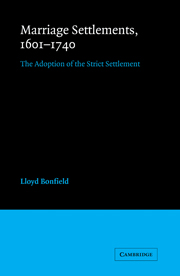Book contents
- Frontmatter
- Contents
- List of tables
- Preface
- List of abbreviations
- Introduction
- 1 The medieval inheritance and the Statute of Uses
- 2 Law in transition: the conflict over restraints upon alienation
- 3 Patterns of marriage settlement 1601–1659: the development of the ‘life estate-entail’ mode
- 4 The emergence of the strict settlement
- 5 The adoption of the strict settlement 1660–1740: Kent and Northamptonshire
- 6 Marriage settlements in perspective: the social and economic aspects
- Conclusion
- Bibliography
- Index
- CAMBRIDGE STUDIES IN ENGLISH LEGAL HISTORY
2 - Law in transition: the conflict over restraints upon alienation
Published online by Cambridge University Press: 07 October 2011
- Frontmatter
- Contents
- List of tables
- Preface
- List of abbreviations
- Introduction
- 1 The medieval inheritance and the Statute of Uses
- 2 Law in transition: the conflict over restraints upon alienation
- 3 Patterns of marriage settlement 1601–1659: the development of the ‘life estate-entail’ mode
- 4 The emergence of the strict settlement
- 5 The adoption of the strict settlement 1660–1740: Kent and Northamptonshire
- 6 Marriage settlements in perspective: the social and economic aspects
- Conclusion
- Bibliography
- Index
- CAMBRIDGE STUDIES IN ENGLISH LEGAL HISTORY
Summary
It is commonplace to consider the century and a quarter between the enactment of the Statute of Uses and the development of the strict settlement as an era of great uncertainty in the land law. Legal historians have cited the succession of cases which invalidated various clauses in settlements and wills, as well as the comments of distinguished members of the bar, to attest to this sense of profound confusion. Indeed, Sir Francis Bacon's oft-quoted statement in his argument in Chudleigh's Case may well summarize the verdict of modern historians: ‘It is likely that Counsellors of the law have advised men in such cases [regarding settlements] that when the cases come to be scanned it is hard to argue how the law will be taken.’ Yet his statement must be read in context, as the argument of counsel; no doubt Bacon's modern brethren often express such reservations to their clients, and have been known to echo similar sentiments in court to bolster their arguments.
The purpose of this chapter is to consider the state of the law regarding the settlement of land in the sixteenth and early seventeenth centuries in order to ascertain the extent of uncertainty and its implications for settlement practice. While it must be conceded that few are the periods in which the common law remained static, neither contemporaries nor modern legal historians have ever effectively demonstrated the extent to which this uncertainty affected the fortunes of the landowning class.
- Type
- Chapter
- Information
- Marriage Settlements, 1601–1740The Adoption of the Strict Settlement, pp. 11 - 45Publisher: Cambridge University PressPrint publication year: 1983
- 1
- Cited by

